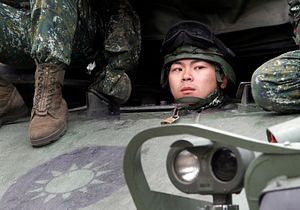Taiwan’s defense ministry says the Chinese People’s Liberation Army (PLA) flew “various military aircraft” close to the island on Tuesday, one week after Taiwan held its first large-scale military drills of 2019 to deter a potential Chinese invasion.
China flew a Sukhoi Su-30 fighter jet and a Shaanxi Y-8 surveillance plane, along with other aircraft, through the Bashi Channel waterway between the Philippines and Taiwan’s Orchid Island, the Ministry of National Defense said on Wednesday. Taiwan’s military sent surveillance ships and aircraft in response before the PLA aircraft returned to base in the south of the Chinese mainland, the ministry said.
The patrol flights marked the latest event in a recent uptick in military action on both sides of the Taiwan Strait. While the PLA has conducted regular patrols close to Taiwanese airspace since the election of Taiwan President Tsai Ing-wen in 2016, the timing of its latest exercise is significant.
Last Thursday, Taiwan held a live-fire drill aimed at improving combat readiness, beginning a slate of combat exercises scheduled for 2019 that Major General Yeh Kuo-hui said earlier this month are aimed at “defending against a possible Chinese invasion.”
Yeh, who is in charge of planning Taiwan’s yearly military exercises, said on January 9 that this year’s drills and training routines incorporate new defense tactics against a Chinese sea invasion, according to Taiwan’s Central News Agency. The exercise schedule has been in the works since midway through 2018, he said.
The schedule of military exercises was released one week after Chinese President Xi Jinping delivered a speech in which he refused to rule out the use of force to assert Chinese sovereignty over Taiwan. Xi’s proposal of a “one country, two systems” framework of governance in Taiwan – equated by observers to that of Hong Kong, over which Beijing asserts significant influence – prompted a swift response from Tsai, who reiterated her stance that Taiwan would never accept such a formula.
Taiwanese anti-invasion exercises and Chinese patrol flights are regular occurrences and do not constitute direct responses to the war of words between the two leaders, but they set the stage for a year in which the Taiwan Strait has already begun to boil with enmity.
In December 2018, prior to the speeches by Tsai and Xi, the Council on Foreign Relations’ Center for Preventive Action named Taiwan as an area to watch in its 2019 Preventive Priorities Survey, which identifies top flashpoints that may affect U.S. policy. Taiwan garnered a Tier II rating (high impact, low likelihood) from the think tank, marking its first appearance on the survey, which cites the possibility for a U.S.-China crisis over Taiwan due to “China’s intensifying political and economic pressure campaign ahead of Taiwan’s elections in 2020.”
Washington provides considerable defense, economic, and diplomatic support to bolster its unofficial relationship with Taipei and the recently enacted Asia Reassurance Initiative Act contains provisions encouraging arms sales from the U.S. to Taiwan. The U.S. Congress cleared the way for a US$330 million arms sale to Taipei last year, set to be the second major weapons package delivered under the Trump administration.
Last Friday, U.S. Chief of Naval Operations John Richardson told reporters in Tokyo that Washington had not ruled out sending an aircraft carrier through the Taiwan Strait, a move that Beijing sees as infringing upon Chinese territory but which the U.S. Navy maintains is a routine passage through international waters – one which it last made in November 2018, angering Chinese leaders.
However, under the current U.S.-China-Taiwan leadership troika, even seemingly benign and regular actions can be interpreted by rival states as potentially malicious.
In October 2018, Xi told China’s Southern Theater Command, responsible for the South China Sea and Taiwan, to “concentrate preparations for fighting a war,” according to state-run broadcaster CCTV.
On Sunday, the state-run Xinhua news agency reported that China would drastically cut its land army to less than 50 percent of total troops while strengthening branches such as the navy, air force, and the division responsible for cyberwarfare.
Taiwan’s military is set to continue its slate of military drills for 2019, which will include the month-long Han Kuang live-fire exercise in the second quarter of the year, joint anti-landing operations in the third quarter, and joint anti-airborne exercises in the year’s final quarter. Of equal significance in 2019 will be the gains Taiwan makes in the realm of cyber defense and information security, especially after Taiwanese legislators and defense officials have warned of the disruptive threats of Chinese-backed “fake news” and influence operations on the island.
On Tuesday, Nikkei Asian Review reported that Taiwan would roll out a plan to ban government employees from using devices manufactured by a list of Chinese tech companies, including smartphone giants Huawei and ZTE. Such a step will be welcomed by observers who have urged that Taiwan boost both its military and cyber defense capabilities to stand its ground in a region increasingly defined by an air of hostility.

































